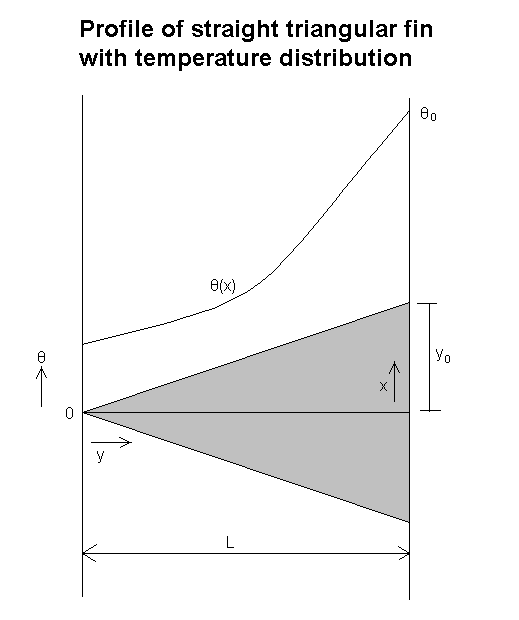

Lastly we will calculate the fin of a triangular profile, or that of a wedge. It is possible to reduce this to that of a wedge, but the equations are beyond the scope of this project. Further information on wedge shaped fins can be found in a paper published by D.R Harper and W.B.Brown in the 1922 National Advisory Committee on Aeronautical Technology Report #158, on page 677.
> restart;
Start with Newton's equation of cooling as always.
>
q:=(y,x)->-k*y(x)*diff(theta(x),x);
eqn1:=-diff(q(y,x),x)=h*theta(x):
eqn2:=simplify(eqn1/k);
![]()
![[Maple Math]](images/proj82.gif)
Here we substitute our equation of a line. It is important to note here that the diagram above is NOT backwards. We just made a small convention to put the heat source at x=L and the tip of the fin at x=0. Thus this will simplify our profile equation to the one shown below.
![]()
![[Maple Math]](images/proj84.gif)
The solution involves a complicated Bessel function of the first kind.
>
s:=dsolve({eqn1,theta(0)=C1},theta(x));
assign(s):
![]()
> theta:=unapply(theta(x),x):
We have the initial condition knowing the temperature at x=L.
>
C1:=solve(theta[0]=theta(L),C1):
theta(x);
![[Maple Math]](images/proj86.gif)
Now we calculate the total heat across the bar.
> qtot:=h*int(theta(x),x):
> qtot:=eval(qtot,x=L)-eval(qtot,x=0);
![[Maple Math]](images/proj87.gif)
The equation for profile area.
>
eqn3:=Area=L*y0/2:
L:=solve(eqn3,L):
Here we have total heat / initial
temperature excess. This gives a simple formula, that is fairly easy to
calculate.
Note, we have replaced the complicated expressions inside the Bessel
functions with a u.
eqn4:=simplify(algsubs(4*sqrt(h/k)*Area*(y0)^(-3/2)=u,qtot),assume=positive);
![[Maple Math]](images/proj88.gif)
However, we need to take a derivative with respect to y0, so we will need to substitute back in to get a y0.
>
eqn11:=u=4*sqrt(h/k)*Area*y0^(-3/2):
solve(eqn11,y0):
y0:=%[1];
![[Maple Math]](images/proj89.gif)
> simplify(eqn4,assume=positive);
![[Maple Math]](images/proj810.gif)
Here we take the derivative to find the maximum value for total heat / initial temperature excess.
> eqn6:=simplify(diff(eqn4/theta[0],u),assume=positive);
![[Maple Math]](images/proj811.gif)
> eqn7:=simplify(eqn6*u^(4/3)*BesselI(0,u)^2*3/2^(2/3)/k^(1/3)/Area^(1/3)/h^(2/3));
![]()
Use a numerical solver because Maple cannot come up with a closed form answer due to the Bessel functions.
> u:=fsolve(eqn7=0,u,1..3);
![]()
Now that we have our most favorable u, we will use that to generate the characteristic length, height, and profile area.
> unassign('y0','L');
> Area:=L*y0/2:
>
eqn11:
y0:=solve(eqn11,y0);
![[Maple Math]](images/proj814.gif)
> eqn12:=simplify(Qtot/theta[0]=eqn4/theta[0],assume=positive);
![[Maple Math]](images/proj815.gif)
> L_eqn:=solve(eqn12,L);
![[Maple Math]](images/proj816.gif)
> unassign('y0','Area'):
> eqn13:=algsubs(y0=Area*2/L,eqn4):
>
Area:=L*y0/2:
L:=solve(eqn11,L):
> eqn14:=Qtot=eqn13:
> y0_eqn:=solve(eqn14,y0);
![[Maple Math]](images/proj817.gif)
> Area_eqn:=L_eqn*y0_eqn/2;
![[Maple Math]](images/proj818.gif)
Here we see that although a lot of heat is lost, the temperature of the fin as a whole is still quite high at the end.
> n:=simplify(theta(0)/theta(L),assume=positive);
![]()